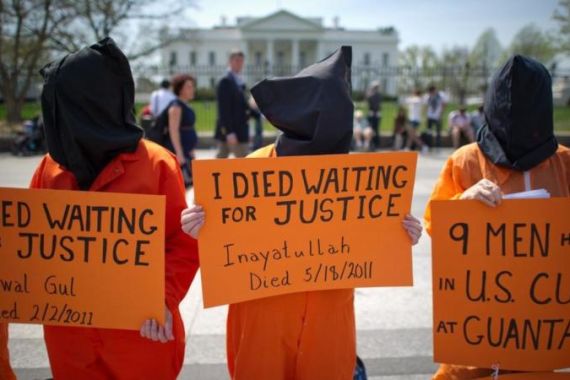The US and enemy prisoners post 9/11
The US government authorised torture as a tool for obtaining intelligence post-9/11, writes Arjun Sethi.

Fear is a powerful human agent. It can cloud our judgment and dim our conscience. Left unchecked, it can skew the moral compass of a nation, leaving destruction in its wake.
A recent bipartisan report by the Constitution project confirms what many have long suspected: US personnel tortured enemy detainees in the months and years following the September 11, 2001, terrorist attacks. The report lays bare a nation so paralysed by fear that it jettisoned longstanding human rights protections in the name of national security.
Unlike prior military campaigns, where torture was prohibited and implicated US personnel investigated, here the US government authorised torture as a tool for obtaining intelligence. The human body, long considered sacrosanct and irreproachable under human rights law, could now be manipulated and tormented in the most heinous ways.
President Bush laid the foundation for the policy by finding that the Geneva Conventions did not apply to al-Qaeda and Taliban detainees. Many of his top advisers agreed, and enlisted the support of lawyers and psychologists. The Justice Department wrote lengthy memos circumventing Geneva, the US Constitution and well-established international law, which prohibits the use of torture under all circumstances. A cadre of psychologists, meanwhile, designed brutal interrogation methods capable of rendering detainees helpless and despondent.
The break was complete. The time-tested rules and processes that had governed America’s treatment of prisoners in Vietnam and Korea were abandoned. Standards etched in the practices and psyche of US personnel for decades were suddenly replaced by a new set of ad-hoc and arbitrary rules.
Ad-hoc because the Department of Defense and US Army never clarified what standards should apply in lieu of Geneva. Arbitrary because they sometimes varied by location. In Afghanistan, for example, detainees were subject to phobia exploitation, suspension of light and sound, and sleep deprivation through shackling and standing. In Guantanamo, detainees faced excruciating stress positions, dietary deprivation, intimidation by dogs and extreme temperatures. Some of these methods were approved by Secretary of Defense Donald Rumsfeld.
Iraq was similar. Despite President Bush’s order that the Conventions applied in Iraq, they were routinely circumvented or ignored. In some cases, groups considered exempt from Geneva, including the CIA, interrogated detainees. In other cases, like Abu Ghraib, there appears to have been a ripple effect: US personnel either ignored the Conventions or believed they had been suspended.
|
|
| ‘US tortured detainees’ after 9/11 attack |
The CIA black sites were the most abominable. Shrouded in mystery and thought to be immune from Geneva, inmates were subject to waterboarding, prolonged stress positions and loud music 24 hours a day. In at least one case, a detainee was placed in a confinement box, where he was deprived of light and air. Some of these practices were authorised by President Bush.
Human rights bodies and humanitarian groups, like the International Committee on the Red Cross, have uniformly condemned these practices, calling many of them torture. So have numerous US judges, who have thrown out an array of detainee statements arguing that evidence obtained through torture is not admissible. The coup de grace comes courtesy of the US government, who previously condemned other countries for engaging in the very same practices.
President Obama has insisted that he wants to look forward, and that culpable US personnel will not be prosecuted. Congress has joined the chorus, widely denouncing calls for a truth commission. Modelled after the South African experience, a commission would offer amnesty in exchange for truthful testimony.
History shows that accountability can come in many forms. The field of transitional justice offers an array of options for addressing human rights abuses, including criminal prosecutions, truth commissions and banning perpetrators from public service.
Silence, however, is not one of them. A commitment to look forward is just another way of saying forget the past.
The fact remains that an array of actors – the President, his advisers, lawyers, psychologists and those on the ground – committed a grave human rights violation. Call it a movie script. President Bush produced it; his top advisers directed it; lawyers and psychologists provided the special effects; and personnel played the part. Only through government support, and the power to review classified information and subpoena witnesses, can this tragic story be told.
In turning away from the past, we forfeit the chance to archive history and understand what happened and why; we surrender the opportunity to ensure that fear and its terrible consequences do not reign triumphant again; and we devalue the rule of law, and its prohibition against torture, a principle centuries in the making.
We also deprive the victims of transparency and their right to an effective remedy – a canon of international law. Unlike the perpetrators, the victims cannot help but look back. They have quotidian reminders: aching pains, terrifying nightmares and gnawing fears.
In 1942, the US government faced another emergency, and forced Japanese Americans into internment camps. It took more than 40 years for Congress to issue a formal apology and award reparations. This time, America must do better.
Arjun Sethi is a lawyer in Washington, DC, and a frequent commentator on civil rights and social justice-related issues. He has written for the Washington Post, USA Today and CNN, among other publications.
Follow him on Twitter: @arjunsethi81
You can follow the editor on Twitter: @nyktweets
